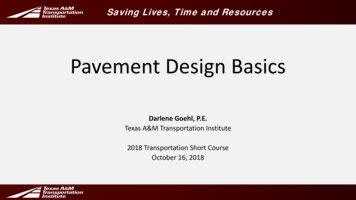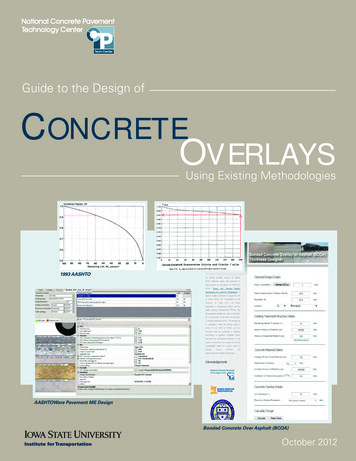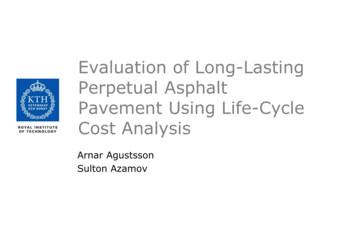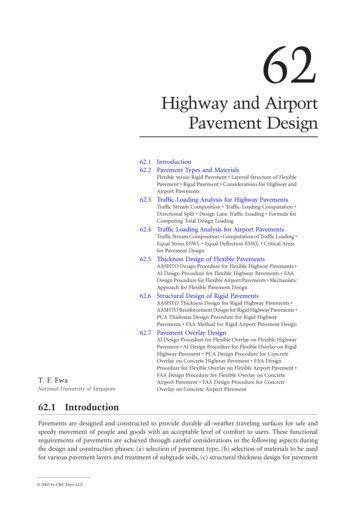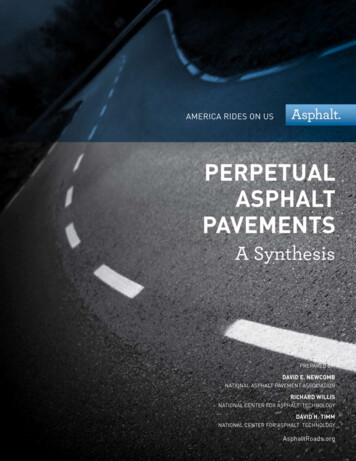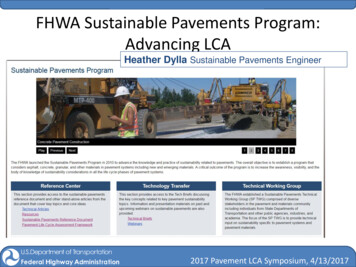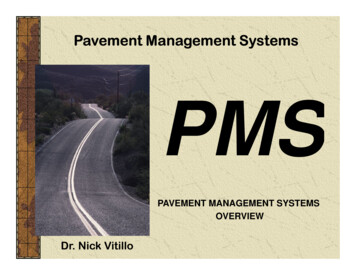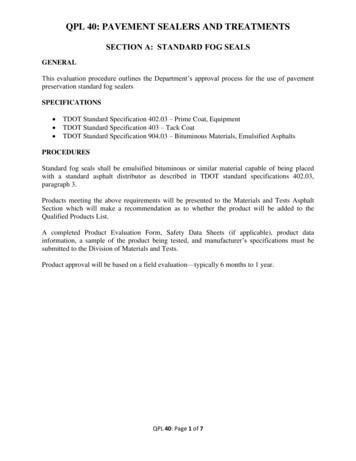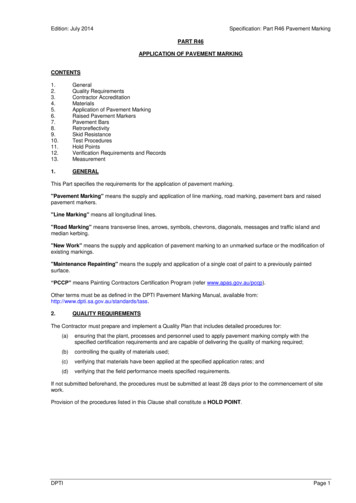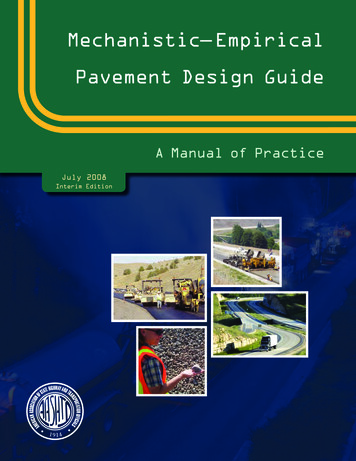
Transcription
Mechanistic– EmpiricalPavement Design GuideA Manual of PracticeJuly 2008Interim Edition
2008 by the American Association of State Highway and Transportation Officials.All rights reserved. Duplication is a violation of applicable law.
2008, by American Association of State Highway and Transportation Officials. All rights reserved.This book, or parts thereof, may not be reproduced in any form without written permission of thepublisher. Printed in the United States of America.Publication Code: MEPDG-1ISBN: 978-1-56051-423-7
iiiAmerican Association of State Highwayand Transportation Officialsexecutive committee2007/2008President: Pete Rahn, MissouriVice President: Allen D. Biehler, P.E., PennsylvaniaSecretary/Treasurer: Carlos Braceras, UtahRegional RepresentativesREGION IDavid A. Cole, Maine, One-Year TermKris Kolluri, New Jersey, Two-Year TermREGION IIStephanie Kopelousos, Florida, One-Year TermButch Brown, Mississippi, Two-Year TermREGION IIIDebra Miller, Kansas, One-Year TermKirk Steudle, Michigan, Two-Year TermREGION IVGary Ridley, Oklahoma, One-Year TermRhonda Faught, New Mexico, Two-Year TermNon-Voting MembersImmediate Past President: Victor M. Mendez, ArizonaExecutive Director: John Horsley, Washington, D.C. 2008 by the American Association of State Highway and Transportation Officials.All rights reserved. Duplication is a violation of applicable law.
iv Mechanistic–Empirical Pavement Design Guide2007/2008JOINT Technical Committee on PAVEMENTSDan Dawood (Chair)PennsylvaniaLinda Pierce (Vice Chair)WashingtonRegion 1Region 3Vacant (Design)KansasAndy Gisi (Design)DelawareRobin Davis (Design)MarylandTim Smith (Materials)New YorkWes Yang (Design)VermontMichael Pologruto (Design)Region 2AlabamaLarry Lockett (Materials)ArkansasPhillip McConnell (Design)LouisianaJeff Lambert (Design)North CarolinaJudith Corley-Lay (Design)South CarolinaAndy Johnson (Design)OtherAASHTO LiaisonKeith Platte andKen KobetskyMinnesotaCurt Turgeon (Materials)MissouriJay F. Bledsoe (Design)OhioAric Morse (Design)IowaChris Brakke (Design)Region 4CaliforniaBill Farnbach (Design)ColoradoRichard Zamora (Design)OklahomaJeff Dean (Design)Vacant (Design)WyomingRick Harvey (Materials)Standing Committee onAviationGary Harris, IAPort Authority of NewYork and New JerseyVacantFHWAPete StephanosTRBAmir Hanna 2008 by the American Association of State Highway and Transportation Officials.All rights reserved. Duplication is a violation of applicable law.
Preface PrefaceThis document describes a pavement design methodology that is based on engineering mechanics andhas been validated with extensive road test performance data. This methodology is termed mechanisticempirical (M-E) pavement design, and it represents a major change from the pavement design methodsin practice today.From the early 1960s through 1993, all versions of the American Association for State Highway andTransportation Officials (AASHTO) Guide for Design of Pavement Structures were based on limited empirical performance equations developed at the AASHO Road Test in the late 1950s. The need for andbenefits of a mechanistically based pavement design procedure were recognized when the 1986 AASHTO Guide for Design of Pavement Structures was adopted. To meet that need, the AASHTO JointTask Force on Pavements, in cooperation with the National Cooperative Highway Research Program(NCHRP) and the Federal Highway Administration (FHWA), sponsored the development of an M-Epavement design procedure under NCHRP Project 1-37A.A key goal of NCHRP Project 1-37A, Development of the 2002 Guide for Design of New and Rehabilitated Pavement Structures: Phase II was the development of a design guide that utilized existing mechanistic-based models and data reflecting the current state-of-the-art in pavement design. This guide was toaddress all new (including lane reconstruction) and rehabilitation design issues, and provide an equitabledesign basis for all pavement types.The Mechanistic-Empirical Pavement Design Guide (MEPDG), as it has now become known, was completed in 2004 and released to the public for review and evaluation. A formal review of the productsfrom NCHRP Project 1-37A was conducted by the NCHRP under Project 1-40A. This review hasresulted in a number of improvements, many of which have been incorporated into the MEPDG underNCHRP Project 1-40D. Project 1-40D has resulted in Version 1.0 of the MEPDG software and anupdated design guide document.Version 1.0 of the software was submitted in April 2007 to the NCHRP, FHWA, and AASHTOfor further consideration as an AASHTO provisional standard and currently efforts are underway onVersion 2.0 of the software. Simultaneously, a group of state agencies, termed lead states, was formed toshare knowledge regarding the MEPDG and to expedite its implementation. The lead states and otherinterested agencies have already begun implementation activities in terms of staff training, collection ofinput data (materials library, traffic library, etc.), acquiring of test equipment, and setting up field sections for local calibration.This manual presents the information necessary for pavement design engineers to begin to use theMEPDG design and analysis method. The FHWA has a web site for knowledge exchange for theMEPDG (http://knowledge.fhwa.dot.gov) 2008 by the American Association of State Highway and Transportation Officials.All rights reserved. Duplication is a violation of applicable law.
viiTABLE OF CONTENTS1. Introduction. . . . . . . . . . . . . . . . . . . . . . . . . . . . . . . . . . . . . . . . . . . . . . . . . . . . . . . . . . . . . . . . . . . . . . . . . . 11.1 Purpose of Manual. . . . . . . . . . . . . . . . . . . . . . . . . . . . . . . . . . . . . . . . . . . . . . . . . . . . . . . . . . . . . . . . 11.2 Overview of the MEPDG Design Procedure . . . . . . . . . . . . . . . . . . . . . . . . . . . . . . . . . . . . . . . . . 12. Referenced Documents and Standards. . . . . . . . . . . . . . . . . . . . . . . . . . . . . . . . . . . . . . . . . . . . . . . . . . . 92.1 Test Protocols and Standards. . . . . . . . . . . . . . . . . . . . . . . . . . . . . . . . . . . . . . . . . . . . . . . . . . . . . . . 92.2 Material Specifications . . . . . . . . . . . . . . . . . . . . . . . . . . . . . . . . . . . . . . . . . . . . . . . . . . . . . . . . . . . 112.3 Recommended Practices and Terminology. . . . . . . . . . . . . . . . . . . . . . . . . . . . . . . . . . . . . . . . . . . 112.4 Referenced Documents. . . . . . . . . . . . . . . . . . . . . . . . . . . . . . . . . . . . . . . . . . . . . . . . . . . . . . . . . . . 113. Significance and Use of the MEPDG . . . . . . . . . . . . . . . . . . . . . . . . . . . . . . . . . . . . . . . . . . . . . . . . . . . 153.1 Performance Indicators Predicted by the MEPDG . . . . . . . . . . . . . . . . . . . . . . . . . . . . . . . . . . . 153.2 MEPDG General Design Approach. . . . . . . . . . . . . . . . . . . . . . . . . . . . . . . . . . . . . . . . . . . . . . . . 163.3 New Flexible Pavement and HMA Overlay Design Strategies Applicable for Use withthe MEPDG. . . . . . . . . . . . . . . . . . . . . . . . . . . . . . . . . . . . . . . . . . . . . . . . . . . . . . . . . . . . . . . . . . . . 173.4 New Rigid Pavement, PCC Overlay, and Restoration of Rigid Pavement DesignStrategies Applicable for Use with the MEPDG. . . . . . . . . . . . . . . . . . . . . . . . . . . . . . . . . . . . . . 203.5 Design Features and Factors Not Included Within the MEPDG Process . . . . . . . . . . . . . . . . 234. Terminology and Definition of Terms. . . . . . . . . . . . . . . . . . . . . . . . . . . . . . . . . . . . . . . . . . . . . . . . . . . 274.1 General Terms . . . . . . . . . . . . . . . . . . . . . . . . . . . . . . . . . . . . . . . . . . . . . . . . . . . . . . . . . . . . . . . . . . 274.2 Hierarchical Input Levels. . . . . . . . . . . . . . . . . . . . . . . . . . . . . . . . . . . . . . . . . . . . . . . . . . . . . . . . . 294.3 Truck Traffic Terms. . . . . . . . . . . . . . . . . . . . . . . . . . . . . . . . . . . . . . . . . . . . . . . . . . . . . . . . . . . . . . 294.4 Smoothness. . . . . . . . . . . . . . . . . . . . . . . . . . . . . . . . . . . . . . . . . . . . . . . . . . . . . . . . . . . . . . . . . . . . . 304.5 Distress or Performance Indicator Terms—HMA-Surfaced Pavements. . . . . . . . . . . . . . . . . . 314.6 Distress or Performance Indicator Terms—PCC-Surfaced Pavements. . . . . . . . . . . . . . . . . . . 315. Performance Indicator Prediction Methodologies—An Overview . . . . . . . . . . . . . . . . . . . . . . . . . 335.1 Calibration Factors Included in the MEPDG. . . . . . . . . . . . . . . . . . . . . . . . . . . . . . . . . . . . . . . . 335.2 Distress Prediction Equations for Flexible Pavements and HMA Overlays. . . . . . . . . . . . . . . 345.3 Distress Prediction Equations for Rigid Pavements and PCC Overlays. . . . . . . . . . . . . . . . . . 496. Hierarchical Input Levels—Deciding on the Input Level. . . . . . . . . . . . . . . . . . . . . . . . . . . . . . . . . . 676.1 Introduction to Hierarchical Input Levels. . . . . . . . . . . . . . . . . . . . . . . . . . . . . . . . . . . . . . . . . . . 676.2 Purpose of the Hierarchical Input Levels. . . . . . . . . . . . . . . . . . . . . . . . . . . . . . . . . . . . . . . . . . . . 676.3 Selecting the Input Level. . . . . . . . . . . . . . . . . . . . . . . . . . . . . . . . . . . . . . . . . . . . . . . . . . . . . . . . . . 687. General Project Information. . . . . . . . . . . . . . . . . . . . . . . . . . . . . . . . . . . . . . . . . . . . . . . . . . . . . . . . . . . 717.1 Design/Analysis Life . . . . . . . . . . . . . . . . . . . . . . . . . . . . . . . . . . . . . . . . . . . . . . . . . . . . . . . . . . . . . 717.2 Construction and Traffic Opening Dates. . . . . . . . . . . . . . . . . . . . . . . . . . . . . . . . . . . . . . . . . . . . 718. Selecting Design Criteria and Reliability Level. . . . . . . . . . . . . . . . . . . . . . . . . . . . . . . . . . . . . . . . . . . 738.1 Recommended Design-Performance Criteria . . . . . . . . . . . . . . . . . . . . . . . . . . . . . . . . . . . . . . . . 738.2 Reliability . . . . . . . . . . . . . . . . . . . . . . . . . . . . . . . . . . . . . . . . . . . . . . . . . . . . . . . . . . . . . . . . . . . . . . 749. Determining Site Conditions and Factors. . . . . . . . . . . . . . . . . . . . . . . . . . . . . . . . . . . . . . . . . . . . . . . 779.1 Truck Traffic. . . . . . . . . . . . . . . . . . . . . . . . . . . . . . . . . . . . . . . . . . . . . . . . . . . . . . . . . . . . . . . . . . . . 779.2 Climate . . . . . . . . . . . . . . . . . . . . . . . . . . . . . . . . . . . . . . . . . . . . . . . . . . . . . . . . . . . . . . . . . . . . . . . . 83 2008 by the American Association of State Highway and Transportation Officials.All rights reserved. Duplication is a violation of applicable law.
viii Mechanistic–Empirical Pavement Design Guide9.3 Foundation and Subgrade Soils. . . . . . . . . . . . . . . . . . . . . . . . . . . . . . . . . . . . . . . . . . . . . . . . . . . . 849.4 Existing Pavements . . . . . . . . . . . . . . . . . . . . . . . . . . . . . . . . . . . . . . . . . . . . . . . . . . . . . . . . . . . . . . 8610. Pavement Evaluation for Rehabilitation Design. . . . . . . . . . . . . . . . . . . . . . . . . . . . . . . . . . . . . . . . . . 8710.1 Overall Condition Assessment and Problem Definition Categories. . . . . . . . . . . . . . . . . . . . . . 8710.2 Data Collection to Define Condition Assessment. . . . . . . . . . . . . . . . . . . . . . . . . . . . . . . . . . . . . 8910.3 Analysis of Pavement Evaluation Data for Rehabilitation Design Considerations. . . . . . . . 10411. Determination of Material Properties for New Paving Materials. . . . . . . . . . . . . . . . . . . . . . . . . 10911.1 Material Inputs and the Hierarchical Input Concept. . . . . . . . . . . . . . . . . . . . . . . . . . . . . . . . 10911.2 HMA Mixtures; Including SMA, Asphalt-Treated or Stabilized Base Layers, andAsphalt Permeable-Treated Base Layers. . . . . . . . . . . . . . . . . . . . . . . . . . . . . . . . . . . . . . . . . . . 10911.3 PCC Mixtures, Lean Concrete, and Cement-Treated Base Layers. . . . . . . . . . . . . . . . . . . . . 11711.4 Chemically Stabilized Materials; Including Lean Concrete and Cement-Treated Base Layer. . 11711.5 Unbound Aggregate Base Materials and Engineered Embankments. . . . . . . . . . . . . . . . . . . 12412. Pavement Design Strategies . . . . . . . . . . . . . . . . . . . . . . . . . . . . . . . . . . . . . . . . . . . . . . . . . . . . . . . . . 12912.1 New Flexible Pavement Design Strategies—Developing the Initial Trial Design . . . . . . . . 12912.2 New Rigid Pavement Design Strategies—Developing the Initial Trial Design . . . . . . . . . . 13613. Rehabilitation Design Strategies. . . . . . . . . . . . . . . . . . . . . . . . . . . . . . . . . . . . . . . . . . . . . . . . . . . . . 14313.1 General Overview of Rehabilitation Design Using the MEPDG. . . . . . . . . . . . . . . . . . . . . . 14313.2 Rehabilitation Design with HMA Overlays . . . . . . . . . . . . . . . . . . . . . . . . . . . . . . . . . . . . . . . 14513.3 Rehabilitation Design with PCC Overlays. . . . . . . . . . . . . . . . . . . . . . . . . . . . . . . . . . . . . . . . . 16414. Interpretation and Analysis of the Results of the Trial Design. . . . . . . . . . . . . . . . . . . . . . . . . . . 18114.1 Summary of Inputs for Trial Design. . . . . . . . . . . . . . . . . . . . . . . . . . . . . . . . . . . . . . . . . . . . . . 18114.2 Reliability of Trial Design. . . . . . . . . . . . . . . . . . . . . . . . . . . . . . . . . . . . . . . . . . . . . . . . . . . . . . . 18114.3 Supplemental Information (Layer Modulus, Truck Applications, and Other Factors). . . . 18214.4 Predicted Performance Values. . . . . . . . . . . . . . . . . . . . . . . . . . . . . . . . . . . . . . . . . . . . . . . . . . . 18414.5 Judging the Acceptability of the Trial Design. . . . . . . . . . . . . . . . . . . . . . . . . . . . . . . . . . . . . . . 185Appendix: Getting Started with the MepdgA.1 Installing the Software. . . . . . . . . . . . . . . . . . . . . . . . . . . . . . . . . . . . . . . . . . . . . . . . . . . . . . . . . . 189A.2 Uninstalling the Software. . . . . . . . . . . . . . . . . . . . . . . . . . . . . . . . . . . . . . . . . . . . . . . . . . . . . . . 190A.3 Running the Software. . . . . . . . . . . . . . . . . . . . . . . . . . . . . . . . . . . . . . . . . . . . . . . . . . . . . . . . . . 190Abbreviations And TermsAbbreviations. . . . . . . . . . . . . . . . . . . . . . . . . . . . . . . . . . . . . . . . . . . . . . . . . . . . . . . . . . . . . . . . . . . . . . . 195Terms . . . . . . . . . . . . . . . . . . . . . . . . . . . . . . . . . . . . . . . . . . . . . . . . . . . . . . . . . . . . . . . . . . . . . . . . . . . . . 196IndexIndex of words. . . . . . . . . . . . . . . . . . . . . . . . . . . . . . . . . . . . . . . . . . . . . . . . . . . . . . . . . . . . . . . . . . . . . . 201 2008 by the American Association of State Highway and Transportation Officials.All rights reserved. Duplication is a violation of applicable law.
List of Figures ixLIST OF FIGURES1-1Conceptual Flow Chart of the Three-Stage Design/Analysis Process for the MEPDG. . . . . . . . . . 21-2Typical Differences Between Empirical Design Procedures and an Integrated M-EDesign System, in Terms of HMA-Mixture Characterization. . . . . . . . . . . . . . . . . . . . . . . . . . . . . . . 31-3Typical Differences Between Empirical Design Procedures and an Integrated M-E DesignSystem, in Terms of PCC-Mixture Characterization . . . . . . . . . . . . . . . . . . . . . . . . . . . . . . . . . . . . . . 41-4Flow Chart of the Steps That Are More Policy Decision-Related and Needed to Complete anAnalysis of a Trial Design Strategy. . . . . . . . . . . . . . . . . . . . . . . . . . . . . . . . . . . . . . . . . . . . . . . . . . . . . . 61-5Flow Chart of the Steps Needed to Complete an Analysis of a Trial Design Strategy. . . . . . . . . . . 73-1New (Including Lane Reconstruction) Flexible Pavement Design Strategies That Can BeSimulated with the MEPDG (Refer to Subsection 12.1); Layer Thickness Not Be Scale. . . . . . . 183-2HMA Overlay Design Strategies of Flexible, Semi-Rigid, and Rigid Pavements That Can BeSimulated with the MEPDG (Refer to Subsection 13.2); Layer Thickness Not Be Scale. . . . . . . 193-3New (Including Lane Reconstruction) Rigid Pavement Design Strategies That Can BeSimulated with the MEPDG (Refer to Subsection 12.2); Layer Thickness Not Be Scale. . . . . . . 213-4PCC Overlay Design Strategies of Flexible, Semi-Rigid, and Rigid Pavements That Can BeSimulated with the MEPDG (Refer to Subsection 13.3); Layer Thickness Not Be Scale. . . . . . . 225-1Graphical Illustration of the Five Temperature Quintiles Used in the MEPDG to DetermineHMA-Mixture Properties for Load-Related Distresses. . . . . . . . . . . . . . . . . . . . . . . . . . . . . . . . . . . 355-2Comparison of Measured and Predicted Total Rutting Resulting from Global Calibration Process 385-3Comparison of Cumulative Fatigue Damage and Measured Alligator Cracking Resultingfrom Global Calibration Process. . . . . . . . . . . . . . . . . . . . . . . . . . . . . . . . . . . . . . . . . . . . . . . . . . . . . . . 415-4Comparison of Measured and Predicted Lengths of Longitudinal Cracking (Top-DownCracking) Resulting from Global Calibration Process. . . . . . . . . . . . . . . . . . . . . . . . . . . . . . . . . . . . . 425-5Comparison of Measured and Predicted Transverse Cracking Resulting from GlobalCalibration Process. . . . . . . . . . . . . . . . . . . . . . . . . . . . . . . . . . . . . . . . . . . . . . . . . . . . . . . . . . . . . . . . . . 465-6Comparison of Measured and Predicted IRI Values Resulting from Global CalibrationProcess of Flexible Pavements and HMA Overlays of Flexible Pavements. . . . . . . . . . . . . . . . . . . 495-7Comparison of Measured and Predicted IRI Values Resulting from Global CalibrationProcess of HMA Overlays of PCC Pavements. . . . . . . . . . . . . . . . . . . . . . . . . . . . . . . . . . . . . . . . . . . 505-8Comparison of Measured and Predicted Percentage JPCP Slabs Cracked Resulting fromGlobal Calibration Process. . . . . . . . . . . . . . . . . . . . . . . . . . . . . . . . . . . . . . . . . . . . . . . . . . . . . . . . . . . . 525-9Comparison of Measured and Predicted Transverse Cracking of Unbounded JPCPOverlays Resulting from Global Calibration Process. . . . . . . . . . . . . . . . . . . . . . . . . . . . . . . . . . . . . . 52 2008 by the American Association of State Highway and Transportation Officials.All rights reserved. Duplication is a violation of applicable law.
Mechanistic–Empirical Pavement Design Guide5-10 Comparison of Measured and Predicted Transverse Cracking for Restored JPCPResulting from Global Calibration Process. . . . . . . . . . . . . . . . . . . . . . . . . . . . . . . . . . . . . . . . . . . . . . 535-11 Comparison of Measured and Predicted Transverse Joint Faulting for New JPCPResulting from Global Calibration Process. . . . . . . . . . . . . . . . . . . . . . . . . . . . . . . . . . . . . . . . . . . . . . 585-12 Comparison of Measured and Predicted Transverse Joint Faulting for Unbound JPCPOverlays Resulting from Global Calibration Process. . . . . . . . . . . . . . . . . . . . . . . . . . . . . . . . . . . . . . 595-13 Comparison of Measured and Predicted Transverse Joint Faulting for Restored (DiamondGrinding) JPCP Resulting from Global Calibration Process. . . . . . . . . . . . . . . . . . . . . . . . . . . . . . . 595-14 Comparison of Measured and Predicted Punchouts for New CRCP Resulting from GlobalCalibration Process. . . . . . . . . . . . . . . . . . . . . . . . . . . . . . . . . . . . . . . . . . . . . . . . . . . . . . . . . . . . . . . . . . 625-15 Comparison of Measured and Predicted IRI Values for New JPCP Resulting from GlobalCalibration Process. . . . . . . . . . . . . . . . . . . . . . . . . . . . . . . . . . . . . . . . . . . . . . . . . . . . . . . . . . . . . . . . . . 645-16 Comparison of Measured and Predicted IRI Values for New CRCP Resulting from GlobalCalibration Process. . . . . . . . . . . . . . . . . . . . . . . . . . . . . . . . . . . . . . . . . . . . . . . . . . . . . . . . . . . . . . . . . . 658-1Design Reliability Concept for Smoothness (IRI). . . . . . . . . . . . . . . . . . . . . . . . . . . . . . . . . . . . . . . . 7510-1 Steps and Activities for Assessing the Condition of Existing Pavements for RehabilitationDesign. . . . . . . . . . . . . . . . . . . . . . . . . . . . . . . . . . . . . . . . . . . . . . . . . . . . . . . . . . . . . . . . . . . . . . . . . . . . . 9112-1 Flow Chart for Selecting Some Options to Minimize the Effect of Problem Soils onPavement Performance. . . . . . . . . . . . . . . . . . . . . . . . . . . . . . . . . . . . . . . . . . . . . . . . . . . . . . . . . . . . . . 13112-2 Limiting Modulus Criteria of Unbound Aggregate Base and Subbase Layers. . . . . . . . . . . . . . . . 13513-1 Steps for Determining a Preferred Rehabilitation Strategy. . . . . . . . . . . . . . . . . . . . . . . . . . . . . . . . 14413-2 Flow Chart of Rehabilitation Design Options Using HMA Overlays. . . . . . . . . . . . . . . . . . . . . . 14513-3 Site Features Conducive to the Selection of the Rubblization Process for RehabilitatingPCC Pavements. . . . . . . . . . . . . . . . . . . . . . . . . . . . . . . . . . . . . . . . . . . . . . . . . . . . . . . . . . . . . . . . . . . . 16013-4 Recommendations for a Detailed Investigation of the PCC Pavement to Estimate RemainingLife and Identifying Site Features and Conditions Conducive to the Rubblization Process. . . . . 16113-5 Evaluate Surface Condition and Distress Severities on Selection of Rubblization Option . . . . . 16213-6 Foundation Support Conditions Related to the Selection of the Rubblization Process. . . . . . . . 16313-7 Overall Design Process for Major PCC Rehabilitation Strategies of All Pavement Types. . . . . . 166A-1 MEPDG Software Screen. . . . . . . . . . . . . . . . . . . . . . . . . . . . . . . . . . . . . . . . . . . . . . . . . . . . . . . . . . . 191A-2 MEPDG Program Layout. . . . . . . . . . . . . . . . . . . . . . . . . . . . . . . . . . . . . . . . . . . . . . . . . . . . . . . . . . . 192A-3 Color-Coded Inputs to Assist User in Input Accuracy . . . . . . . . . . . . . . . . . . . . . . . . . . . . . . . . . . . 192A-4 MEPDG Context Sensitive Help (Brief Description of Input). . . . . . . . . . . . . . . . . . . . . . . . . . . . 193A-5 MEPDG Tool Tip Help. . . . . . . . . . . . . . . . . . . . . . . . . . . . . . . . . . . . . . . . . . . . . . . . . . . . . . . . . . . . . 194 2008 by the American Association of State Highway and Transportation Officials.All rights reserved. Duplication is a violation of applicable law.
List of Tables xiLIST OF -410-510-610-710-811-111-211-311-411-5Reflection Cracking Model Regression Fitting Parameters. . . . . . . . . . . . . . . . . . . . . . . . . . . . . . . . 47Assumed Effective Base LTE for Different Base Types . . . . . . . . . . . . . . . . . . . . . . . . . . . . . . . . . . . 56Predominant Input Levels Used in Recalibration Effort of the MEPDG. . . . . . . . . . . . . . . . . . . . 69Design Criteria or Threshold Values Recommended for Use in Judging the Acceptabilityof a Trial Design. . . . . . . . . . . . . . . . . . . . . . . . . . . . . . . . . . . . . . . . . . . . . . . . . . . . . . . . . . . . . . . . . . . . 74Levels of Reliability for Different Functional Classifications of the Roadway. . . . . . . . . . . . . . . . . 76Minimum Sample Size (Number of Days per Year) to Estimate the Normalized AxleLoad Distribution—WIM Data. . . . . . . . . . . . . . . . . . . . . . . . . . . . . . . . . . . . . . . . . . . . . . . . . . . . . . 78Minimum Sample Size (Number of Days per Season) to Estimate the Normalized TruckTraffic Distribution—Automated Vehicle Classifiers (AVC) Data. . . . . . . . . . . . . . . . . . . . . . . . . 78TTC Group Description and Corresponding Truck Class Distribution Default ValuesIncluded in the MEPDG Software. . . . . . . . . . . . . . . . . . . . . . . . . . . . . . . . . . . . . . . . . . . . . . . . . . . . 81Definitions and Descriptions for the TTC Groups . . . . . . . . . . . . . . . . . . . . . . . . . . . . . . . . . . . . . . 82Summary of Soil Characteristics as a Pavement Material . . . . . . . . . . . . . . . . . . . . . . . . . . . . . . . . . 86Checklist of Factors for Overall Pavement Condition Assessment and Problem Definition . . . . 89Hierarchical Input Levels for a Pavement Evaluation Program to Determine Inputs forExisting Pavement Layers for Rehabilitation Design Using the MEPDG. . . . . . . . . . . . . . . . . . . . 92Field Data Collection and Evaluation Plan. . . . . . . . . . . . . . . . . . . . . . . . . . . . . . . . . . . . . . . . . . . . . . 95Guidelines for Obtaining Non-Materials Input Data for Pavement Rehabilitation. . . . . . . . . . . 96Use of Deflection Basin Test Results for Selecting Rehabilitation Strategies and inEstimating Inputs for Rehabilitation Design with the MEPDG . . . . . . . . . . . . . . . . . . . . . . . . . . . 98Summary of Destructive Tests, Procedures, and Inputs for the MEPDG. . . . . . . . . . . . . . . . . . . 100Distress Types and Severity Levels Recommended for Assessing Rigid PavementStructural Adequacy . . . . . . . . . . . . . . . . . . . . . . . . . . . . . . . . . . . . . . . . . . . . . . . . . . . . . . . . . . . . . . . 105Distress Types and Levels Recommended for Assessing Current Flexible PavementStructural Adequacy . . . . . . . . . . . . . . . . . . . . . . . . . . . . . . . . . . . . . . . . . . . . . . . . . . . . . . . . . . . . . . . 106Major Material Types for the MEPDG . . . . . . . . . . . . . . . . . . . . . . . . . . . . . . . . . . . . . . . . . . . . . . . 110Asphalt Materials and the Test Protocols for Measuring the Material Property Inputsfor New and Existing HMA Layers . . . . . . . . . . . . . . . . . . . . . . . . . . . . . . . . . . . . . . . . . . . . . . . . . . 111Recommended Input Parameters and Values; Limited or No Testing Capabilities for HMA(Input Levels 2 or 3) . . . . . . . . . . . . . . . . . . . . . . . . . . . . . . . . . . . . . . . . . . . . . . . . . . . . . . . . . . . . . . . 115PCC Material Input Level 1 Parameters and Test Protocols for New and Existing PCC. . . . . . 118Recommended Input Parameters and Values; Limited or No Test Capabilities for PCCMaterials (Input Levels 2 or 3). . . . . . . . . . . . . . . . . . . . . . . . . . . . . . . . . . . . . . . . . . . . . . . . . . . . . . . 119 2008 by the American Association of State Highway and Transportation Officials.All rights reserved. Duplication is a violation of applicable law.
xii Mechanistic–Empirical Pavement Design Guide11-6 Chemically Stabilized Materials Input Requirements and Test Protocols for New andExisting Chemically Stabilized Materials. . . . . . . . . . . . . . . . . . . . . . . . . . . . . . . . . . . . . . . . . . . . . . 12211-7 Recommended Input Levels 2 and 3 Parameters and Values for Chemically StabilizedMaterials Properties. . . . . . . . . . . . . . . . . . . . . . . . . . . . . . . . . . . . . . . . . . . . . . . . . . . . . . . . . . . . . . . . 12311-8 C-Values to Convert the Calculated Layer Modulus Values to an Equivalent ResilientModulus Measured in the Laboratory. . . . . . . . . . . . . . . . . . . . . . . . . . . . . . . . . . . . . . . . . . . . . . . . . 12411-9 Unbound Aggregate Base, Subbase, Embankment, and Subgrade Soil MaterialRequirements and Test Protocols for New and Existing Materials . . . . . . . . . . . . . . . . . . . . . . . . 12511-10 Recommended Input Levels 2 and 3 Input Parameters and Values for Unbound AggregateBase, Subbase, Embankment, and Subgrade Soil Material Properties. . . . . . . . . . . . . . . . . . . . . . 12613-1 Definitions of the Surface Condition for Input Level 3 Pavement Condition Ratings andSuggested Rehabilitation Options. . . . . . . . . . . . . . . . . . . . . . . . . . . . . . . . . . . . . . . . . . . . . . . . . . . . 14713-2 Candidate Repair and Preventive Treatments for Flexible, Rigid, and Composite Pavements. . . . 14913-3 Summary of Major Rehabilitation Strategies and Treatments Prior to Overlay Placementfor Existing HMA and HMA/PCC Pavements. . . . . . . . . . . . . . . . . . . . . . . . . . . . . . . . . . . . . . . . 15013-4 Data Required for Characterizing Existing PCC Slab Static Elastic Modulus for HMAOverlay Design. . . . . . . . . . . . . . . . . . . . . . . . . . . . . . . . . . . . . . . . . . . . . . . . . . . . . . . . . . . . . . . . . . . . 15613-5 Recommendations for Performance Criteria for HMA Overlays of JPCP and CRCP. . . . . . . . 15713-6 Recommendations for Modifying Trial Design to Reduce Distress/Smoothness for HMAOverlays of JPCP and CRCP. . . . . . . . . . . . . . . . . . . . . . . . . . . . . . . . . . . . . . . . . . . . . . . . . . . . . . . . 15813-7 PCC Rehabilitation Options—Strategies to Correct Surface and Structural Deficienciesof All Type of Existing Pavements. . . . . . . . . . . . . . . . . . . . . . . . . . . . . . . . . . . . . . . . . . . . . . . . . . . . 16513-8 Summary of Key Aspects of Joint Design and Interlayer Friction for JPCP Overlays. . . . . . . . . 16813-9 Data Required for Characterizing Existing PCC Slab. . . . . . . . . . . . . . . . . . . . . . . . . . . . . . . . . . . 16913-10 Description of Existing Pavement Condition. . . . . . . . . . . . . . . . . . . . . . . . . . . . . . . . . . . . . . . . . . . 16913-11 Summary of Factors That Influence Rehabilitate
NCHRP Project 1-40D. Project 1-40D has resulted in Version 1.0 of the MEPDG software and an updated design guide document. Version 1.0 of the software was submitted in April 2007 to the NCHRP, FHWA, and AASHTO for further consideration as an AASHTO provisional standard and currently efforts are underway on Version 2.0 of the software.
